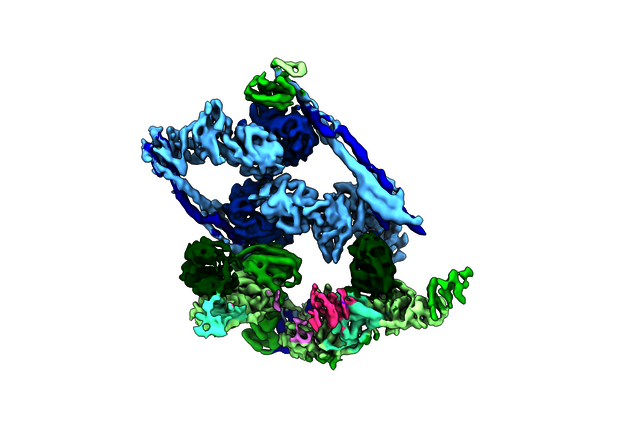UAP56 steers transport of messenger RNA: The conductor of genetic information

How does genetic information such as a genetic blueprint travel through a cell to guide the construction of proteins? Researchers at the Vienna BioCenter have solved a decade-old puzzle, uncovering how the information molecule mRNA travels from the cell’s nucleus to its periphery. The study, now published in the journal Nature, reveals the protein UAP56 at the center of the cell’s information-managing machinery.
Every cell depends on the controlled flow of genetic information. While the DNA remains securely stored in the nucleus, its instructions must exit the nucleus, for proteins—the building blocks of life—to be made. These instructions exit the nucleus as special molecules, messenger RNAs (mRNAs), in a process critical to every eukaryotic organism. Many key proteins involved in mRNA export are long known, but how they work together to get mRNAs out of the nucleus remained unclear.
Now, researchers at two institutes of the Vienna BioCenter - the Institute of Molecular Biotechnology (IMBA) of the Austrian Academy of Sciences and the Research Institute of Molecular Pathology (IMP) – showed in a study published in the journal Nature how mRNA is processed and taken out of the nucleus: a single protein, UAP56, acts as a central coordinator to orchestrate the long-known machinery that handles mRNA.
A molecular orchestra
“UAP56 is at the center of the process,” says Ulrich Hohmann, first author of the study. “It uses energy to remodel mRNA–protein complexes and then hands these complexes off between different molecular machines that guide the mRNAs towards the nuclear pore, where they exit the nucleus into the periphery of the cell.”
Led by Clemens Plaschka (IMP) and Julius Brennecke (IMBA), the scientists combined advanced cryo-electron microscopy (cryo-EM) with AI-based protein modelling, molecular and cellular experiments. Building on previous research from the Plaschka lab, the study identified several key functions of UAP56. First, UAP56 helps assemble and remodel the transcription-export complex (TREX), which packages newly made mRNAs into export-ready particles. After this, UAP56 itself binds the mRNA to trigger TREX disassembly, yielding an export-ready complex that travels to the nuclear pore complex —the cell’s gateway between nucleus and cytoplasm.
The researchers also showed that TREX-2, another protein complex, serves as a docking station at the nuclear pore. TREX-2 directly recognizes mRNA-bound UAP56, acting simultaneously as a release mechanism: a part of TREX-2 acts as a wedge that pries UAP56 open, freeing its bound mRNA to enable its transport through the nuclear pore complex.
This step-by-step process ensures that messages from the nucleus to the cytoplasm proceed in a directed sequence – like a carefully conducted orchestra, where every instrument plays its part on cue, led by the beat of the conductor UAP56.
“We provide a structural framework of this key cellular pathway, from the time the mRNA has been made until it reaches the nucleus’ exit,” explains Plaschka. “While all the key proteins of this pathway had been discovered over the past 30 years, we only now could put things together, giving us a full view of the process,” adds Brennecke.

Implications for future research
By revealing this full view, the study closes a major knowledge gap and opens opportunities for further research. The scientists hope to build on their findings to investigate nuclear gene expression, its regulation and quality control, and what goes wrong in diseases that are linked to defects in mRNA export or during viral infections.
Original Paper
Hohmann U., Graf M., Tirián L., Belén Pacheco-Fiallos B., Schellhaas U., Fin L., Handler D., Philipps AW., Riabov-Bassat D., Faraway RW., Pühringer T., Szalay MF., Roitinger E., Brennecke J., Plaschka C. An ATP-gated molecular switch orchestrates human messenger RNA export. Nature. DOI: 10.1038/s41586-025-09832-z
Further Reading
https://www.imp.ac.at/news/article/scientists-reshape-our-understanding-of-messenger-rna